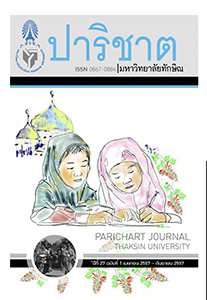Chumchonsatta : Development through Community Identity in Southern Border, Thailand.
Main Article Content
Abstract
ทางสนับสนุนความเข้มแข็งของเครือข่ายชุมชนศรัทธาในการพัฒนาบนฐาน อัตลักษณ์ชุมชน โดยใช้ระเบียบวิธีวิจัยเชิงคุณภาพในการเก็บข้อมูล ทั้งจากการ ศึกษาเอกสาร และการศึกษาภาคสนาม ด้วยวิธีการสัมภาษณ์ การสังเกต และ การประชุมเชิงปฏิบัติการ
การศึกษาพบว่าความรุนแรงนับแต่ พ.ศ. 2547 เป็นต้นมา ได้เกิดขึ้น ดำรงอยู่และก่อผลกระทบอย่างไพศาล แต่การก่อตัวของเครือข่ายชุมชนศรัทธา ที่มีจุดเริ่มต้นจากการสร้างพลังชุมชนและค่อย ๆ ยกระดับสู่การสร้างทางเลือก ใหม่ พัฒนากระทั่งขับเคลื่อนเป็นส่วนหนึ่งของขบวนการประชาชน ทำให้เกิด ผลสำเร็จในการสร้างนวัตกรรมการพัฒนาทที่ตั้งอยู่บนฐานอัตลักษณ์ชุมชนและ วัฒนธรรม การพัฒนากิจกรรมใหม่ ๆ ที่สอดคล้องกับความคาดหวังและความ ต้องการของชุมชน การคิดค้นกิจกรรมสู่ความยั่งยืน และการพึ่งตนเอง เกิดความ ภาคภูมิใจและเชื่อมั่นในแนวทางการพัฒนา หน่วยงานภายนอกให้การยอมรับ และมีทัศนคติที่ดีในการส่งเสริม/ สนับสนุนการดำเนินงานของชุมชนมากขึ้น
กระนั้น การดำเนินงานของเครือข่ายชุมชนศรัทธา ยังมีปัญหาหลาย ประการทั้งในระดับชุมชน/ เครือข่าย ปัญหาสถานะและตำแหน่งแห่งที่ และ ปัญหาการเสพติดอุดมคติ จึงเสนอว่าเครือข่ายชุมชนศรัทธาควรปรับโครงสร้าง และระบบบริหารที่เน้นการกระจายอำนาจ มีกระบวนการเสริมสร้างศักยภาพ แกนนำทุกระดับ มีการสื่อสารสาธารณะ และการสร้างความสัมพันธ์อันดีกับ เครือข่ายองค์กรประชาชน/ประชาสังคม ในเชิงนโยบายรัฐบาลควรกำหนดให้ กระทรวงต่าง ๆ ปรับเปลี่ยนกระบวนทัศน์การพัฒนา โดยมุ่งนำ “การพัฒนา เสริมสร้างความเข้มแข็งของชุมชน สร้างพื้นที่การมีส่วนร่วม” อย่างจริงจังและ เป็นรูปธรรมทั้งนี้ ควรจัดให้มีกองทุนเพื่อการพัฒนาชุมชนสำหรับชุมชนใน จังหวัดชายแดนใต้
Chumchonsatta : Development through Community Identity in Southern Border, Thailand
Nathapong Chitniratna, Waeromlee Waebula and Noparin Subirat
The aim of this article is to present the community evolution which includes problems and approaches to support and strengthen Chumchonsattha Network suited with community identities. The study applied the qualitative research method, started with documentary research and followed by field research. The field researches were conducted by interview, observation, and workshops.
The study found that since 2004, violence has happened and profoundly impacted to a foundation of Chumchonsattha Network. The Network was established through community empowerment to improve new development alternatives that harmonized with community’s expectations and needs. Through many activities, people process was started. Innovation from the people process leaded to the success in community development based on local identity and culture. Improvement in new activities led to community independence and sustainability. These activities assisted in the formation of proudness and confidence among people in the development process. The process has been well accepted by other organizations as they continuedto provide further support to Chumchonsattha Network operation.
However, the operation of Chumchonsattha Network consisted of many problems from the community level to the network level. These problems included Chumcohomsattha Network status, position, and idealization of the concept. This study suggested that the Chumchonsattha Network should reform its structure and management practice. Its management practice should be decentralized and equipped with capacity strengthening for leaders at all levels. In addition, the Chumchonsattha Network should enhance public communication and foster relationships with other networks and civil organizations. The study made an additional suggestion on policy in which Thai government should require an alteration of development concept at ministial level. The concept should support community strengthening through community participation with tangible output. Consideration should be made on providing community fund for community development in the southern border province.


